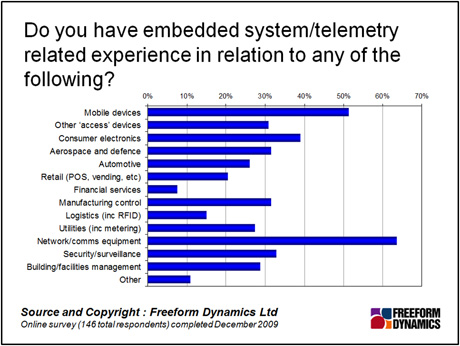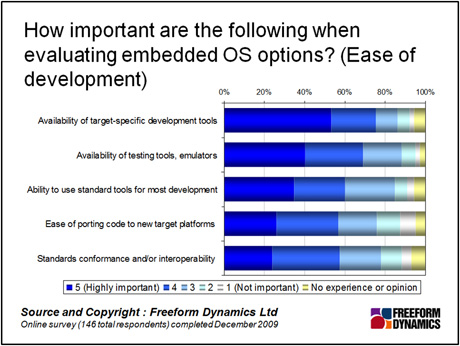Is anyone still developing software anymore, particularly in smaller-scale, “embedded” systems running on platform-specific operating systems? Despite the best efforts of packaged software vendors, software development never went away – indeed, the annual barometer studies that Freeform Dynamics undertakes with readers of The Register repeatedly shows that “custom application development” is always one of the top areas for investment. And in a recent mini-poll, when we asked you about embedded systems in particular, we found considerable interest in this area. But what’s guiding the decision about the embedded OS to use?
A quick glance at the figure below highlights that embedded systems development is being undertaken in a wide cross section of industries. The figure also illustrates that many developers of such applications operate in multiple industries. Such a result is not terribly surprising given the increasing importance of solutions using embedded software and the relatively small numbers of skilled and experienced programmers comfortable in this space, at least when compared to traditional enterprise applications.

As the chart shows, embedded systems are popping up across all industrial sectors, everywhere from high consumer-touch areas such as automotive systems, mobile devices through to the heart of the business supply chain and manufacturing and along to specialised high value verticals such as aerospace, defence and medical systems.

With developers of embedded applications being in some demand, it begs the question of what do they look for in the operating systems that might be deployed to support these systems? Naturally enough the availability of target-specific development tools and testing tools / emulators top the list. Close behind comes a desire to be able to use standard development tools for the majority of the code work, again perhaps not too surprising given that many of the developers are likely to be working on a broad range of solutions.
The most interesting aspect of the second figure is that “standards conformance and / or interoperability” figure at the bottom of the list when developers are evaluating embedded operating systems options. The “ease of porting code to new target platforms” performs only slightly better as a desired attribute. These last two results are surprising as in other areas of applications development these are highly desirable attributes.
It might well be the case that decisions concerning the choice of operating system on which to build embedded applications are more tightly associated with the underlying device that will house the application than in other areas of software development. Equally it might be that the relative youth of embedded systems development may also be having a major influence in these results. Do you have any opinions here? Please let us have your feedback in the comments section below.
However with this an area that is highly likely to grow in importance there are challenges ahead for all suppliers working in these areas.
Through our research and insights, we help bridge the gap between technology buyers and sellers.





Have You Read This?
From Barcode Scanning to Smart Data Capture
Beyond the Barcode: Smart Data Capture
The Evolving Role of Converged Infrastructure in Modern IT
Evaluating the Potential of Hyper-Converged Storage
Kubernetes as an enterprise multi-cloud enabler
A CX perspective on the Contact Centre
Automation of SAP Master Data Management
Tackling the software skills crunch